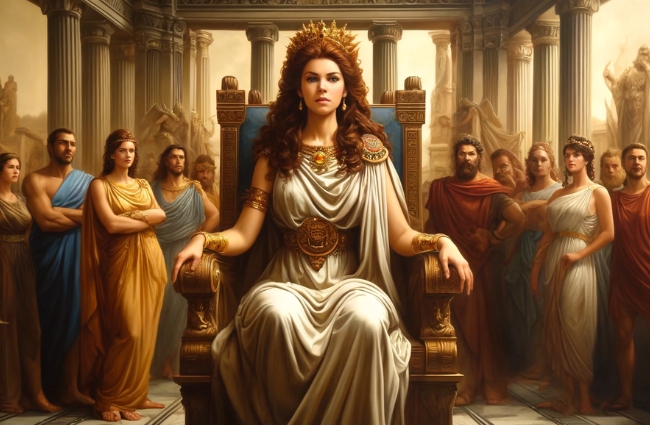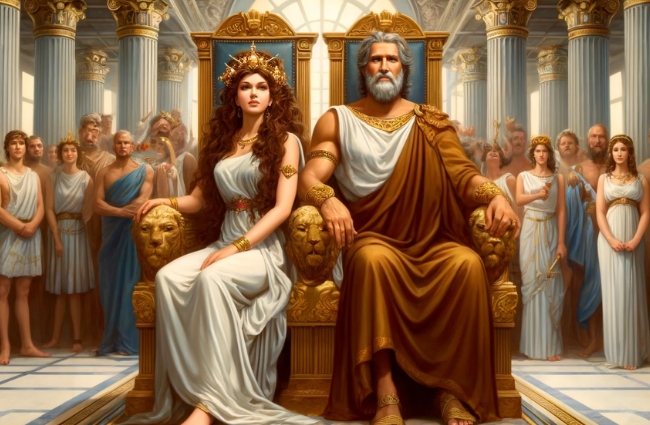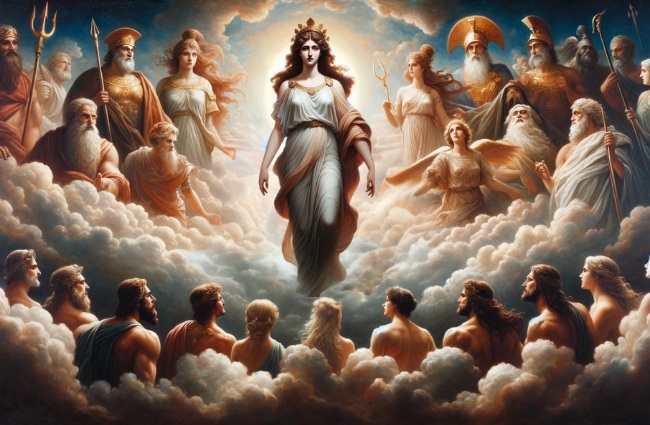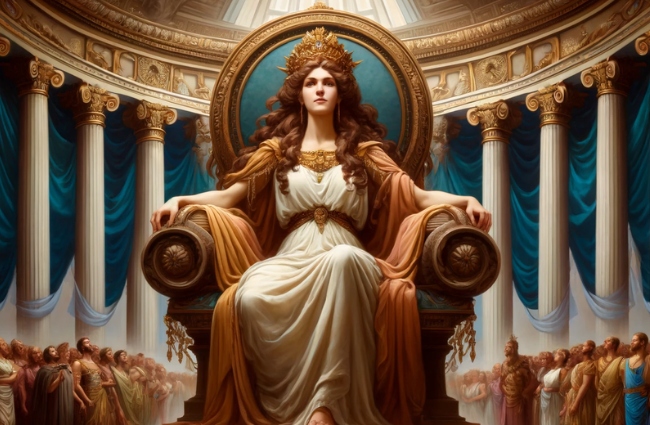Home » Goddess Hera: Facts About the Ancient Greek Deity of Marriage
Goddess Hera: Facts About the Ancient Greek Deity of Marriage
Meet Goddess Hera, the formidable Greek deity of marriage, childbirth, and a whole lot more.
As the queen of the Olympian gods, she embodies the ideals of fidelity and matrimony, often acting to uphold the sanctity of marriage, despite the notorious infidelities of her husband, Zeus.
In this post, we dive into all the important facts about Hera like who her family was, how she got along with her husband Zeus, and what her role was in the Greek pantheon.
Learn how her story has shaped cultural perceptions of loyalty and relationships throughout history. See how and why her narrative has inspired countless works of art and literature over the centuries.
Let’s explore the profound impact of the goddess Hera together.
Who is Goddess Hera?

In Greek mythology, Goddess Hera is the ancient deity of marriage, women, childbirth, and family. She oversees the sanctity and protection of nuptials and the family. That was her realm.
Married to Zeus, the king of the gods, she often plays a role that reflects her status and influence, embodying the ideals of matrimonial fidelity.
And because of her marriage to the king of the gods, Hera is known as the queen of the gods.
Naturally, this made her a central figure in Greek mythology.
Her own marriage is famously tumultuous due to Zeus’s many infidelities.
But her realm extends beyond just overseeing marriage; she is also a protector of women, especially during childbirth, which aligns with her domain over family matters.
It’s one of the reasons she’s sometimes referred to as a feminist goddess.
Her complex nature has made her a subject of both reverence and fear.
As you’ll soon see, Goddess Hera embodies both the nurturing and vengeful aspects of womanhood and divinity.
Hera, the Goddess of Revenge
As Zeus’ wife, she often had to deal with his infidelity, which sparked a resentful nature in her.
So on top of being the deity of marriage, women, and childbirth, she became known as Hera, the goddess of revenge.
Her wrath wasn’t limited to Zeus’ mistresses; it extended to their offspring and anyone who helped them. Even those that committed adultery against their significant others.
In story after story, she is described as trying to make life miserable for anyone she thought was at fault for her husband’s lapses in judgement.
One of her most famous acts of revenge was against Hercules, Zeus’ son with a mortal woman. She drove him mad, leading him to commit heinous acts, including killing his own family.
And she continued to cause him trouble throughout his Twelve Labors.
Another example is her relentless torment of Io, a mortal woman loved by Zeus. She transformed Io into a cow and sent a gadfly to sting her constantly, forcing her to wander around endlessly.
Her vendettas often showed her more violent and unforgiving side, reflecting the darker aspects of her role in the Greek pantheon.
Hera, goddess of revenge was a fitting title because she continued to go after anyone that caused her marital harm, or who she thought caused harm.
10+ Facts About Hera
One of the main facts about Hera is that she became one of the twelve Olympian gods after marrying Zeus.
This made her Queen of the Gods.
Here’s a list of some interesting facts about her that have the most significance and that came to define her role in Greek mythology:
1. Protector of Heroes: Despite her reputation for vengeance, she also played roles in protecting heroes. She was notably the patron and helper of Jason and the Argonauts in their quest for the Golden Fleece.
2. Childbirth: She is not only the goddess of marriage, but also closely associated with fertility and childbirth. She is the mother of Eileithyia, another goddess of childbirth, who assists women in labor, thereby extending her influence over this critical aspect of family life.
3. Marriage to Zeus: One of the primary facts about Hera is that she was not only Zeus’s wife but also his sister. This was common among Greek deities to maintain control and preserve their divine lineage within the same family.
4. Her Golden Throne: She possessed a magnificent golden throne on Mount Olympus, reflecting her status as queen of the gods. This throne was said to be crafted by Hephaestus, her son, and had magical properties.
5. Her Own Children Without Zeus: In some less famous stories, she conceived and bore children parthenogenetically (without male involvement). Hephaestus is sometimes said to be born without a father, solely from this goddess, which was her retaliation to Zeus for giving birth to a child on his own without her involvement.
6. Her Role in the Iliad: In Homer’s “Iliad”, she is a key divine player, showing her strategic mind and political acumen. She is depicted as manipulating other gods and even Zeus himself to influence the outcome of the Trojan War, which she did partly out of sympathy for the Greeks and partly due to her own rivalries and agendas among the gods.
7. Heraia in Her Honor: Another of the fun facts about Hera is that she had festivals in her honor. The Heraia is the most famous of those festivals. Interestingly, it included a series of foot races for unmarried women, which is one of the earliest recorded instances of female athletic competitions.
8. Roman Counterpart: Her counterpart in Roman mythology is Juno. While sharing many attributes and stories, Juno’s character in Roman culture has some distinct elements, emphasizing her role as a protector and an entity connected to the welfare of the state and its people.
9. Argos as a Favored City: Argos is one of her favorite cities, and she was particularly revered there. The largest and most celebrated temple dedicated to her, known as the Heraion, was located near Argos. This temple was a major center of her worship.
10. Her Intervention in Paris’s Decision: In one telling of this competition involving the Golden Apple, which indirectly led to the Trojan War, she was one of the three goddesses who claimed the apple inscribed “To the fairest.” She tried to bribe Paris, the prince of Troy, with the offer of becoming a powerful king if he chose her over Aphrodite and Athena. This act highlights her competitive nature and her willingness to use power and kingship as leverage.
These 10 Hera facts reveal a lot about the role she played as queen of the gods.
Relationship Between Goddess Hera and Zeus

He was king of the Gods. When they married, she became queen of the gods.
However, Hera and Zeus were not only husband and wife, but they were also brother and sister.
Zeus was able to arrange this marriage largely due to his cunning and persistence.
He did it by transforming himself into a disheveled cuckoo because he knew she loved animals. Especially if they were in distress.
Feeling pity for the bird, the goddess held it to her breast to warm it, at which point Zeus transformed back into his divine form.
Overwhelmed and, according to some writings, seduced by the gesture and Zeus’s power, she agreed to wed him.
That’s the story of how Zeus tricked Hera into marrying him.
Their relationship was fraught with tension, primarily due to Zeus’s constant infidelities.
His numerous affairs with goddesses and mortals alike often incited her wrath, leading her to take payback not only on his lovers, but also on the offspring of these liaisons.
Ironically, never did she cheat on Zeus because of his betrayals.
Despite these issues, there are hints in various myths about Hera that their relationship wasn’t as bad as some might suggest.
His efforts to woo her and convince her to marry him, and some stories where he tries to appease her wrath, suggest a form of love, albeit a complicated and tumultuous one.
The devotion and commitment she had to the institution of marriage were central to her identity and actions, making her the patroness of married women and familial loyalty.
Her role as the goddess of marriage and fidelity kept her faithful to him, despite his own indiscretions.
Hera’s Family Tree

As the majestic queen of the gods in Greek mythology, she has a family tree as complex and fascinating as her stories.
Since she was a central figure among the Olympians, understanding Hera’s family relationships offers insight into her motivations and actions throughout mythology.
Parents of Hera
She was born to the Titans Cronus and Rhea, two of the most significant deities in the Greek mythological hierarchy.
Her parents played crucial roles in the cosmic drama of the gods, with Cronus being known for his harsh rule over the Titans until his son, Zeus, overthrew him.
Hera’s Children
As you might already know, goddess Hera and Zeus had a marriage that brought several children into the divine family.
Here’s a list of the more notable ones:
Hephaestus, the god of blacksmiths, craftsmanship, and fire. Interestingly, mythology varies on his paternity; some suggested he was born from the goddess alone, without Zeus’s involvement, possibly as an act of defiance or independence.
Ares, son of Hera and the god of war, is known for his fierce and tumultuous nature.
Hebe, the goddess of youth, who served nectar and ambrosia to the gods, helping them maintain their immortality.
Eileithyia, the goddess of childbirth, who played a critical role in ensuring the safe delivery of children in the mortal and divine realms.
Among her children, Ares and Hephaestus stand out prominently. Ares, who was more fierce, embodies the destructive and chaotic aspects of war, often clashing with other gods and heroes in mythology.
Hephaestus, on the other hand, was the weaker son of Hera and contrasts with his brother. Hephaestus had a more creative and peaceful disposition.
That was despite his tumultuous origin story and his mother’s contentious relationship with him, stemming from the fact that he was deformed.
In exploring her family tree, we see not only the complexities of divine relationships but also the reflections of human emotions and social dynamics. All projected onto the canvas of mythological narratives.
The children of Hera are a reminder of the importance of lineage and heritage in ancient Greek mythology.
But her family relationships were not just limited to her immediate offspring.
Her interactions with Zeus’s children from other relationships were marked by strife and vengeance, reflecting her protective nature over her own children and her status as the goddess of marriage and fidelity.
Hera’s Siblings
Goddess Hera’s siblings are among the prominent figures in Greek mythology.
Her brothers and sisters were:
• Zeus: King of the Olympian gods and Hera’s husband.
• Poseidon: God of the sea.
• Hades: God of the underworld.
• Demeter: Goddess of agriculture and fertility.
• Hestia: Goddess of hearth and home.
Each sibling had a unique domain, influencing different aspects of the world.
Zeus, as the ruler of the gods, oversaw Mount Olympus and held supreme power.
Poseidon, with his trident, controlled the seas, while Hades ruled the underworld, governing the realm of the dead.
Demeter’s blessings brought fertility to the earth, and Hestia ensured the warmth and harmony of the home.
Together, these siblings’ stories interwove with Hera’s, creating a rich tapestry of divine interactions and epic narratives that continue to fascinate readers today.
What Does Hera Look Like?

When it comes to the question of what does Hera look like, we only have a few ancient writings to go by.
A description of her physical appearance appears in Homer’s “Iliad”: He says she is regal and beautiful, often adorned with luxurious clothing and jewelry.
In many artistic depictions, she often appears as a mature woman, signifying her status as the queen of the gods and the goddess of marriage. She exudes an aura of authority and matronly grace.
Her clothing is often that of a long, flowing robe, richly decorated and suitable for her status as queen of the gods.
These robes are sometimes depicted in colors like deep blue or peacock green, reflecting her association with the sky and the peacock, which became one of Hera’s symbols.
Her facial expressions in art are often serious, reflecting her role as the protector of marriage and a figure who does not tolerate disrespect or infidelity lightly.
She is often adorned with fine jewelry, including necklaces, earrings, and bracelets, all of which signify the uniquely divine position she holds.
These artistic representations reinforce Hera’s identity and status within the pantheon of Greek gods, capturing both her beauty and her potent symbolism as a deity of power and matrimony.
Other Names for Hera Goddess of Marriage
The Greek goddess of marriage and family is known by various epithets that reflect her roles, and areas of influence.
Here’s a list of other names Goddess Hera was known by:
• Teleia (“Goddess of Perfection”): This epithet signifies her role as the goddess of marriage, emphasizing her involvement in the completion and perfection of the union between couples.
• Basileia (“The Queen”): This title highlights her position as the queen of the gods, indicating her authority and regal status on Mount Olympus.
• Argive (“Deity of Argos”): This epithet is linked to the city of Argos, one of the main centers of her worship, indicating her strong connection with that region.
• Boopis (“Goddess of Ox Eyes”): This epithet refers to her large, striking eyes, which are often associated with beauty and majesty.
• Zygia (“Deity of the Yoke”): This epithet underscores her role in overseeing marriage and partnerships, symbolizing the union or “yoke” between partners.
• Eileithyia (“Goddess of Childbirth”): This title emphasizes her role in childbirth and nurturing the family, suggesting her protective nature over mothers and newborns.
• Antheia (“The Flower-Bearer”): This epithet links her to fertility and growth, with “antheia” referring to flowers, indicating her connection to the blooming aspect of nature.
Each of Hera’s epithets sheds light on different aspects of her significance within Greek mythology and the pantheon. They give a unique perspective on her role.
Hera in Literature
Goddess Hera appears in many ancient texts and stories.
Some key sources include:
Homer: In the “Iliad” and “Odyssey,” he describes her role among the Olympian gods.
Hesiod: In “Theogony,” Hesiod outlines the genealogy of Greek gods, detailing her family.
Ovid: The “Metamorphoses” by Ovid contains stories where this goddess, known as Juno in Roman mythology, appears.
These classical authors provide the most well-known accounts of her and the role she played in Greek mythology.
Her interactions with Zeus, the hero Hercules, and other mythical figures are explored in these sources, offering deeper insights into her motives, and impact on the broader Greek mythological narrative.
Additionally, Apollodorus is another ancient source that provides information about her in “The Library,” a comprehensive collection of Greek legends.
This work outlines her lineage and her role in various stories, including her relationships with other gods and goddesses.
Conclusion to Goddess Hera
Goddess Hera carried a lot of clout in Greek mythology. And the fact that she didn’t cheat on Zeus speaks to her commitment to the sanctity of marriage. Even with all of his cheating and manipulation.
As the Queen of the Gods, her significance was undeniable.
Her enduring presence in art and literature shows her lasting impact on culture.
Understanding all the important Hera facts provides valuable insights into the dynamics of the Olympian gods and the ancient Greek worldview.
Her fierce protection of marriage and family, coupled with her often vengeful reactions to Zeus’s infidelities, highlight the complexities and dualities of her character, making her one of the most intriguing figures in mythology.
All of these facts about Goddess Hera continue to inspire discussions about loyalty and the complexities of relationships.
Related Articles
Table of Contents
2024 All rights reserved.
